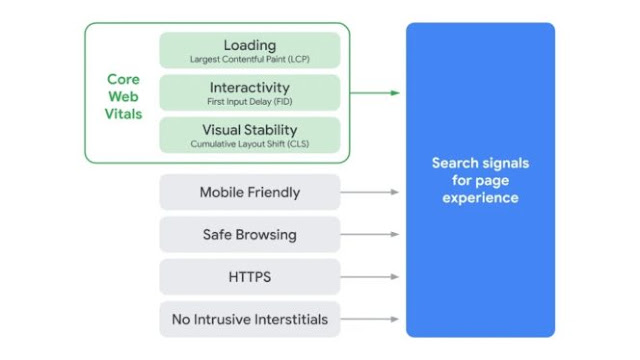Google uses some algorithm in ranking websites on SERPs, it is less than 3
months since the 2020 Google Core Algorithm was updated but Google is already
looking ahead to 2021. Google has just announced a next update of the 2021
core algorithm with user experience being the main criteria for raking
websites on its SERPs.
The “Google Page Experience” core update
In an official statement published recently, Google announced that the new core algorithm update will be mainly centered on providing users with the best experience. Sites will be ranked based on how web users interact with their various web pages. Sites with bad user experience will lose its ranking on Google’s SERP, while those with excellent user experience will move up.
This new update has been tagged “Google Page Experience” will also use
existing factors like page speed, HTTPS (SSL Certificate), page’s
mobile-friendliness, safe browsing, and ads placement in line with its core
web vitals (Largest Contentful Paint, First Input Delay, and Cumulative
Layout Shift ) as its main criterion for ranking pages.
existing factors like page speed, HTTPS (SSL Certificate), page’s
mobile-friendliness, safe browsing, and ads placement in line with its core
web vitals (Largest Contentful Paint, First Input Delay, and Cumulative
Layout Shift ) as its main criterion for ranking pages.
 |
||
| Criteria for evaluating the user experience for a website. Credits: Google |
Factors For Google’s Core Web Vitals
As earlier stated, there will be 3 core web vitals that are focused on
giving users the best experience, and these web vitals will be used to rank
all websites, they are;
giving users the best experience, and these web vitals will be used to rank
all websites, they are;
Largest Contentful Paint (LCP): This is the time taken for a page to load its main contents that are visible to users. This factor shows how fast the contents of your web page is visible to users. If you want to have a
pass mark in this factor, your webpages’ LCP score must be below 2.5
seconds.
pass mark in this factor, your webpages’ LCP score must be below 2.5
seconds.
First Input Delay (FID): This factor measures page responsiveness
and interactivity, it focuses on the response time between when a user
clicks on a button or URL and when the browser recognizes and responds to
this action. Websites with an FID score less than 100ms
(milliseconds) will get a pass mark in this core criterion.
and interactivity, it focuses on the response time between when a user
clicks on a button or URL and when the browser recognizes and responds to
this action. Websites with an FID score less than 100ms
(milliseconds) will get a pass mark in this core criterion.
Cumulative Layout Shift (CLS): Visual stability is taken into account here, factors such as layout offsets (how the visible web elements change positions on a webpage) are used. This is important because Google is trying to prevent misclick from users (a user trying to click a link but mistakenly clicks another because the web elements are clustered or irresponsive when the page is scrolled. CLS below 0.1 will have a pass mark from Google.
 |
| The Three Core Web Vitals Used By Google. Source: Chromium |
Other Minor Factors Used By Google To Measure User Experience
Mobile-Friendliness: Almost 80% of web users access the internet from their mobile devices, so mobile-friendliness is a huge factor in user experience. Google has free tools that can be used to check how mobile-friendly your pages are, and if they are suitable for mobile browsers.
HTTPS Protocol: HTTPS is the safe way for users to surf any web page, pages are tp broadcast in HTTPS to give its users a secured connection. Google has a tool that can be used to test the security of any website.
Safe Browsing: This is a huge step taken in the fight against
piracy, pirated contents (contents without the owner’s permission), social
engineering (contents that make visitors harmful activities), or even a
website notorious for its malware, should not be found on your webpages.
Pages defaulting this factor might end up being deindexed from Google’s
SERPs.
piracy, pirated contents (contents without the owner’s permission), social
engineering (contents that make visitors harmful activities), or even a
website notorious for its malware, should not be found on your webpages.
Pages defaulting this factor might end up being deindexed from Google’s
SERPs.
No intrusive Ads: The aim of posting things on a web page, is for others to easily have access to them. Avoid using pop-ups that blocks the main content of your webpage when users are surfing your website.
Core Update To Be Released In 2021
Google also announced that this core update is slated for 2021 due to the current situations caused by the COVID-19 coronavirus pandemic.
Webmasters should expect this core update in 2021.
Webmasters should expect this core update in 2021.
The exact date this will be rolled out was not announced, so Trybeweb is
not sure if they will be an announcement 6-months prior to the day that
the 2021 core algorithm is updated. However, website owners are advised
to start implementing these criteria so they can easily adapt to the
changes.
not sure if they will be an announcement 6-months prior to the day that
the 2021 core algorithm is updated. However, website owners are advised
to start implementing these criteria so they can easily adapt to the
changes.





